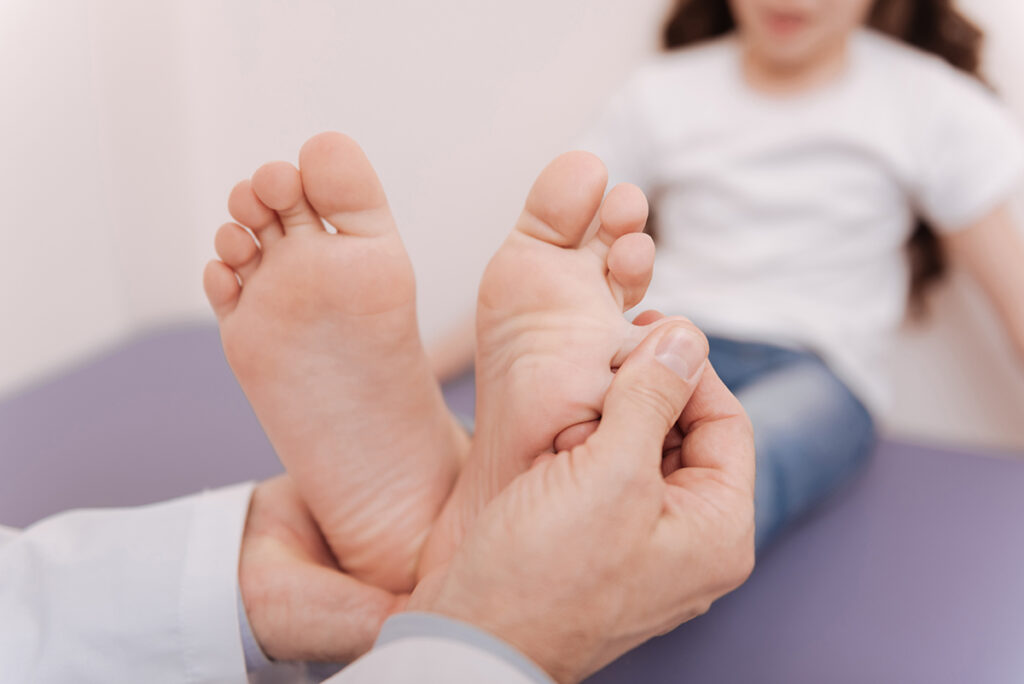Children are not small adults; their physiology is different and as a result, they may be diagnosed and treated differently for myriad disorders and types of injuries. Most children are referred to our practice by their pediatrician or an ER doctor. But as a parent, how do you know when to have your child seen by a local pediatric orthopedist to address their orthopedic condition or injury?
While the scope of pediatric orthopedics is quite broad, the conditions which necessitate a consultation with a local pediatric orthopedist fall into two general categories: from heredity or injury.
Genetics and Birth Play a Role
While many deformities or abnormalities are detected during prenatal ultrasounds or various neonatal screenings—such as clubfoot, thumb anomalies or polydactyly (the presence of an extra digit)—certain hereditary conditions and circumstances surrounding the actual birth also suggest that your newborn be evaluated by a pediatric orthopedist.
There are several leading factors behind these conditions of which parents should be aware:
- A family history of orthopedic deformities should suggest the infant be evaluated by a pediatric orthopedist, even if no abnormalities were detected during prenatal screening.
- Medical conditions that cause low fluid levels in a mother’s womb also suggest the newborn should be evaluated by a local pediatric orthopedist.
- Down Syndrome and other genetic conditions such as extra, missing, or irregular chromosomes can lead to the presence of scoliosis or pelvic and other bone development issues.
- First-time mothers who deliver a breech baby or whose parent or sibling also had a breech delivery should have their infant evaluated for hip dysplasia
Trauma Requires Specialized Medical Attention
As children become more mobile, start to walk, play sports and become more active in general, they are also more prone to injuries. How does a parent know when some icing and pain reliever is enough or a trip to the specialist is in order? Some warning signs that your child should be seen by a specialist are:
- If your child is favoring a limb or has a swollen joint for more than two or three days, parents should take the child for an X-ray. This is especially true in children under 10 years of age because their softer bones make them more prone to fractures rather than mere sprains.
- In children under the age of eight, we see many cases where a child limps for no apparent reason, a condition that lasts for a few hours up to a few days. A visit to your child’s orthopedist would be well advised since the cause could be a bacterial infection, Lymes or a viral infection.
- With more children now three- and four-season athletes, their bodies have less time to rest; overuse is most assuredly a path to injury. Parents of young athletes may face some resistance from their child after they jam a finger or injure a knee, because they want to finish out the season first. However, the earlier you receive a diagnosis and subsequent intervention, the easier the treatment will likely be and the recovery, smoother.
- It’s always better to err on the side of caution and bring your child in sooner rather than later. Early intervention may ensure that a fracture, for example, will heal in the correct position or preclude the need for more extensive treatment like surgery if the injury is diagnosed too late.
- Children with weak ankles and that are often twisting them on and off the field, as well as jammed fingers, should be looked at by a specialist.
Fortunately, seeing a local pediatric orthopedist is easier than ever these days and helps alleviate the burden on our neighborhood emergency rooms. We offer urgent care hours Monday through Thursday 5 – 8 pm and on Saturdays 10 am – 2 pm in our Cedar Knolls office, no appointment required.



